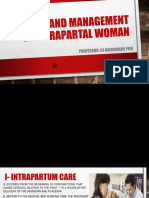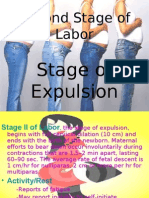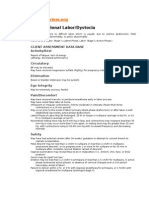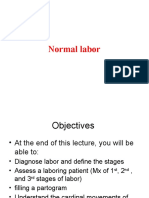Untitled
Untitled
Uploaded by
MON RUSSEL FRIASCopyright:
Available Formats
Untitled
Untitled
Uploaded by
MON RUSSEL FRIASCopyright
Available Formats
Share this document
Did you find this document useful?
Is this content inappropriate?
Copyright:
Available Formats
Untitled
Untitled
Uploaded by
MON RUSSEL FRIASCopyright:
Available Formats
Basic Factors Involved for Effective Contraction to Occur 1.
Evaluate fetal position, presentation, size & or
twinning.
1. Contractile enzyme ATP (adenosine triphosphate) 2. Non engagement of fetal head that may indicate
2. Influence of major electrolyte - Calcium, sodium and contracted pelvis
potassium 3. Note any known uterine or fetal anomalies
3. Specific contractile protein - actin and myosin 4. X-ray pelvimetry to evaluate CPD
4. Epinephrine and norepinephrine 5. Monitor vital signs, contraction pattern and FHT every
5. Oxytocin from posterior pituitary hormone 15 minutes
6. Estrogen, progesterone, prostaglandin 6. Trial labor may be entertained (6-hour labor monitoring
to evaluate progress)
Complications of Labor and Delivery 7. Last recourse is cesarean section if more than 6 hours
with maternal exhaustion and fetal distress.
1. Dystocia - abnormal, inefficient & difficult, prolonged
and more painful labor which may be mechanical or Management & Nursing Interventions
functional. 1. IF OP -
a) Relive back due to sacral pressure- (Back rubs &
a) Mechanical Dystocia - anything that can obstruct the frequent change in position)
passageway b) Monitor character and frequency of contractions
Maternal Causes and FHT
1. Contracted pelvis c) Administer IV line to prevent DHN & provide
2. Obstructive tumor (ovarian/ uterine fibro myoma) glucose needed for effective contraction
3. Ineffective contractions (maternal fatigue, d) Rotate fetal head when cervix is fully dilated
exhaustion, F/E imbalances, hypoglycemia) (EXTERNAL CEPHALIC VERSION)
Fetal Causes An attempt to turn the fetus from a breech or
1. Failure of vertex to rotate (occiput posterior or shoulder presentation to a vertex presentation.
occiput transverse) e) Give encouragement & reassurance to the woman
2. Fetal mal presentation (shoulder, brow, face, throughout labor
breech)
3. Malformation of fetus (hydrocephalus, 2. IF BREECH PRESENTATION - Labor is longer
anencephaly) because soft buttocks does not aid in cervical
dilatation compared to vertex
b) Functional Dystocia - this refers to uterine a) Amniotomy is not done until well engage due to
dysfunction or inertia greater chances of cord prolapse Breech does not
1. Inertia - timed honor term to denote sluggishness of fill the pelvic cavity 100%.
contraction that deviate from the normal contractions b) ELFA using Piper Forceps as indicated
that becomes ineffectual. c) CS if shoulder presentation
Contributory Factors NOTE: Posterior presentation is common among females with
a) Uterine anomalies (Infantile uterus/ septum or cornuate) android, anthropoid, or contracted pelvis. Baby delivers with
b) Over distention of uterus (hydramnios, twinning, caput succedaneum & molding if delivered vaginally.
macrosomia)
c) Cervical scar from previous surgery
d) Anesthesia given too early Complication with the Power or Force of Labor
Risks Involved Due to Prolonged Labor Definition of terms
1. Postpartum infection 1. Dysfunctional Labor - denotes sluggishness of
2. Hemorrhage contractions or that the force of labor is less than usual.
3. Infant mortality
Classification
Causes
a) Primary - occurring on the onset of labor
1. Large fetus b) Secondary - occurring later in labor
2. Hypoactive, hyperactive, uncoordinated uterine 2. Ineffective Uterine Force - have less strength of
contractions uterine contraction than usual or rapid but Ineffective.
3. Uterine anomalies
4. Analgesia given too early in labor
Assessment Classification of Uterine Contraction
1. Hypotonic Uterine Contraction - Contraction is
inadequate (lack intensity) ineffective irregular painless,
coordinated but are too week to expel the baby out. Characteristics
Contractions are infrequent (not more than 2-3 times in 1. Muscle of the uterus is in the state of greater than
10 minutes). normal tension
This occurs in the active phase & tend to occur after 2. Contractions are painful & ineffective for
administration of anesthesia. accomplishing dilatation
When cervix is 3-4 cm & bladder full preventing 3. UC is erratic in frequency, duration and intensity
descent. 4. Usually occurs in latent phase
It also occurs in multiple gestation & hydramnios when 5. Contractions are uncoordinated and involved only a
uterus is lax portion of uterus
If uterus becomes exhausted-uterus may not contract in
the postpartum period leading to Intervention
bleeding. 1. Provide rest with the aid of sedatives (Morphine 16 mg
Intervention to reduce uterine contraction
2. Administer IV fluids to maintain hydration &
a) Pelvis is re-evaluated (pelvimetry) electrolyte balance
b) IV fluid is started for hydration & maintain F/E balance 3. Observe for normal uterine contraction when woman
c) Oxytocin may be given if pelvic size is adequate, fetal awakens
position, presentation & station are Normal. 4. Darkening room lights and decrease noise for rest and
d) Monitor FHT and uterine contraction (Duration, sleep
interval and frequency) 5. Prepare for LCCS PRN
e) If presenting part is engaged, cephalic, ripened cervix
ready for birth, no CPD and fetus is mature by date, Dangerous Effect
NSD may be allowed 1. Lack of relaxation may not allow optimal uterine artery
Complication filling so it can lead to fetal anoxia early in the latent
phase.
1. Tetanic contraction may ensue intermittent UC with Apply uterine & fetal external monitor whose pain
increased irritability & fibrillary contractions seems to be out of proportion to help identify that
2. Can cause abruptio resting phase between contractions is adequate and
3. Uterine rupture FHT is not showing late deceleration.
4. Fetal hypoxia
5. Pathologic retraction ring (Bandl's ring) Implication
Physiologic Ring - hard bands that forms around the "Second Stage Arrest" - LCCS is necessary because uterine
uterus at the junction of the upper and lower uterine contraction is strong but uterine contraction is ineffective and no
segment & interferes with fetal descent. cervical dilatation.
Implication Nursing DX
1. Prostaglandin gel may be given to ripen the cervix 1. Fatigue and anxiety R/T prolonged labor
(Evening primrose, misoprostol) 2. Fluid volume deficit as imposed by NPO
2. Oxytocin augmentation if no complication 3. Knowledge deficit about outcome of pregnancy and
3. Report maternal and fetal distress immediately effect on the baby
2. Hypertonic Uterine Contraction - Contractions that Uncoordinated Contractions - contractions that occur so close
occur frequently & commonly seen in latent phase. It to one another that don't allow good Cotyledon filling.
occurs because more than one uterine pacemaker
stimulate contraction or because muscle fibers of uterus Erratic - no relaxation between contractions
don't repolarize or relax after contraction "wiping it Presents as painful, frequent though irregular
clean" to accept a new pacemaker or new command. contractions that does not cause effacement
It is more painful than usual due to lack of relaxation Or dilatation. It is important that malpresentation or
and anoxia of uterine cells result. It may not allow posterior presentation to be ruled out.
optimal uterine artery filling resulting to fetal anoxia
early in latent phase. Management
1. Oxytocin may be indicated in the following conditions
a) Fetus is in longitudinal lie- cephalic b) Cervix is ripe and ready for birth
c) Presenting part is engaged e) Fetus is mature by date
d) No CPD f) L/S ratio 2:1
2. Stop the contraction & rest the mother for a Maternal Complications
period of time. When contractions resume
spontaneously the condition will be resolved 1. Laceration/ hemorrhage
& labor will progress normally. 2. Infection
3. If all measures fail-induction and 3. Abruptio
augmentation of labor follows in order to 4. Uterine rupture if birth canal is not readily
assist labor that has started spontaneously but distensible
is not effective Fetal Complications
a) Oxytocin - careful observation during infusion
is an important nursing responsibility. Done 1. Intracranial hemorrhage - due to sudden
only when all the criteria above is met release of pressure from the head
4. No oxytocin drip if criteria above is not met 2. Fetal Anoxia
5. Cervical ripening - How? Cervix is expected
Assessment findings
to be firm to soft in consistency
a) Stripping or ironing the membranes or 1. Tetanic uterine contractions
separating the membranes from the lower 2. Rapid labor and delivery
uterine segment manually by gloved hands 3. Strong contractions that rupture the
b) Laminaria Technique - suppository of membranes spontaneously
seaweed that swell in contact with cervical 4. Desire to push
secretions
c) Insertion of Prostaglandin (Misoprostol, Nursing Care
Cytotec) - client must remain on bed side
1. Do not leave the patient alone
lying to absorb the drug. Other drug used are
2. Monitor FHT- to detect hypoxia from tetanic
HNBB, Evening primrose inserted vaginally-
contractions
gel like Where 6 capsules are inserted
3. Inform patient of what is happening
vaginally 1000mg/capsule. They may be
4. Assists with delivery
instructed to come back when contractions
5. Explain precipitate labor in simple terms
become more regular.
6. Never hold the baby back to uterus
d) Oxytocin drip induction may be started after
7. Inspect for laceration and assist in the
12 hours
episiorrhaphy
8. Maintain sterile environment as possible
9. Rupture membranes if necessary
Precipitate Labor - a woman who give birth with only 10. Support baby's head as it emerges, preventing
a few rapidly occurring contractions or labor that is too rapid delivery with gentle pressure
completed in 3 hours after onset of true labor.
Nursing DX
Characteristics
1. Trauma to mother and fetus from strong,
1. Cervical dilatation that occurs at a rate of 5 cm frequent uterine contractions
or more per hour in PRIMI 2. Maternal anxiety resulting from unexpected
and unusual labor pattern
Risk Factors
1. Multiparity - most common
2. Trauma
3. Large pelvis and lax soft tissues
4. Small fetus in good position
5. Severe emotional stress
6. Labor induction by Oxytocin
7. Early amniotomy
8. History of previous precipitate labor
You might also like
- Common Causes of Dysfunctional Labor:: DystociaNo ratings yetCommon Causes of Dysfunctional Labor:: Dystocia8 pages
- Dystocia Due To Abnormalities To Powers: Uterine DysfunctionNo ratings yetDystocia Due To Abnormalities To Powers: Uterine Dysfunction6 pages
- Complications_with_Power_(Force_of_Labor)No ratings yetComplications_with_Power_(Force_of_Labor)12 pages
- Complications of Intrapartum and Post PartumNo ratings yetComplications of Intrapartum and Post Partum8 pages
- Complications During Labor and Delivery: I. Dysfunctional Labor A. DystociaNo ratings yetComplications During Labor and Delivery: I. Dysfunctional Labor A. Dystocia16 pages
- Assesment and Monitoring During 2nd Stage of LabourNo ratings yetAssesment and Monitoring During 2nd Stage of Labour11 pages
- Dysfunctional Labor and Associated Stages of LaborNo ratings yetDysfunctional Labor and Associated Stages of Labor4 pages
- Abnormal Labor and Infertility 2016 PDFNo ratings yetAbnormal Labor and Infertility 2016 PDF12 pages
- Distosia Kelainan His: Elvira Dian Islamiati IIANo ratings yetDistosia Kelainan His: Elvira Dian Islamiati IIA9 pages
- WEEK 5-NCM-109-LECTURE-PPTX With Recorded DiscussionNo ratings yetWEEK 5-NCM-109-LECTURE-PPTX With Recorded Discussion74 pages
- MCN Lect Module 2.5 Complications of Labor and Birth 1 and 2No ratings yetMCN Lect Module 2.5 Complications of Labor and Birth 1 and 27 pages
- W4 - Abnormal Labor and Delivery ComplicationsNo ratings yetW4 - Abnormal Labor and Delivery Complications4 pages
- (Patho OB) Dystocia Due To Abnormalities in Power and Passage-Dr. Ahyong-Reyes (Bernabe)No ratings yet(Patho OB) Dystocia Due To Abnormalities in Power and Passage-Dr. Ahyong-Reyes (Bernabe)5 pages
- Uterine Prolapse Is Falling or Sliding of The Womb (Uterus) From Its Normal Position Into The Vaginal AreaNo ratings yetUterine Prolapse Is Falling or Sliding of The Womb (Uterus) From Its Normal Position Into The Vaginal Area16 pages
- Prolonged Labour: (Dystocia) : ObjectivesNo ratings yetProlonged Labour: (Dystocia) : Objectives9 pages
- Laporan Pendahuluan Asuhan Keperawatan Persalinan NormalNo ratings yetLaporan Pendahuluan Asuhan Keperawatan Persalinan Normal25 pages
- The Labor Progress Handbook: Early Interventions to Prevent and Treat DystociaFrom EverandThe Labor Progress Handbook: Early Interventions to Prevent and Treat DystociaNo ratings yet
- Hernia, (Different Types) A Simple Guide To The Condition, Diagnosis, Treatment And Related ConditionsFrom EverandHernia, (Different Types) A Simple Guide To The Condition, Diagnosis, Treatment And Related Conditions5/5 (1)
- An Esthetic Implant Temporization Alternative Utilizing The Essix Matrix Drs. Christopher J. Baer and Gary M. RadzNo ratings yetAn Esthetic Implant Temporization Alternative Utilizing The Essix Matrix Drs. Christopher J. Baer and Gary M. Radz6 pages
- Assessment of Fundamental Knowledge 2013No ratings yetAssessment of Fundamental Knowledge 201310 pages
- Guidelines For The Management of Superior Vena Cava ObstructNo ratings yetGuidelines For The Management of Superior Vena Cava Obstruct2 pages
- Faculty Status: Pakistan Medical & Dental Council IslamabadNo ratings yetFaculty Status: Pakistan Medical & Dental Council Islamabad8 pages
- "Save Lives! It's Your Turn!": Workshop & SymposiumNo ratings yet"Save Lives! It's Your Turn!": Workshop & Symposium6 pages






























































































